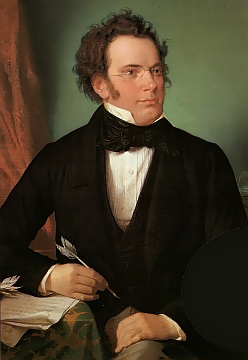Schubert, Piano Quintet in A Major (“Trout”)
 Schubert’s “Trout” Quintet gets its name from the fourth movement (at 21:21), a set of variations on Schubert’s song Die Forelle (trout). The quintet was composed in 1819 but not published until 1829, after Schubert’s death.
Schubert’s “Trout” Quintet gets its name from the fourth movement (at 21:21), a set of variations on Schubert’s song Die Forelle (trout). The quintet was composed in 1819 but not published until 1829, after Schubert’s death.
The work has something of a unique place in the chamber music repertoire because of its instrumentation. Piano quintets were not uncommon at the time, but the standard instrumentation was a string quartet (two violins, viola, and cello) plus piano. Schubert dropped the second violin and added a double bass. And he didn’t simply have the bass play along with the cello to add some extra depth as might be expected at the time. He gave the bass its own independent part. As a result, the piece has a different timbre overall. The bass provides a foundation that allows the piano to play almost exclusively in the upper range. It gives the quintet a bright and cheerful sound. Homer Ulrich writes in his Chamber Music (Columbia Univ. Press 1948):
Hardly any work of Schubert’s, or of many another composer, is as brilliant, as sparkling, and as alive as the Forellen Quintet.
There is one possible model for the instrumentation in a rearrangement by Johann Nepomuk Hummel of his Septet Op. 74, one movement of which was featured here last year.
The notes to the video say that the pianist and bassist are students at the New England Conservatory who were invited to perform with the resident string quartet. There’s nothing unusual about that, but I did find something surprising about the students and faculty. Did you notice? The faculty are all reading off of laptops, and both students are using old-fashioned paper.



